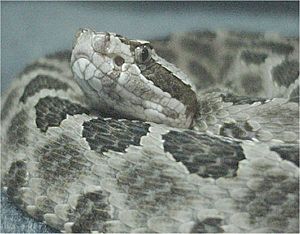Western massasauga facts for kids
Quick facts for kids Western massasauga |
|
|---|---|
 |
|
| Conservation status | |
| Scientific classification | |
| Genus: |
Sistrurus
|
| Species: |
tergeminus
|
| Synonyms | |
|
|
The western massasauga (scientific name: Sistrurus tergeminus) is a type of rattlesnake. You can find this snake in the southwestern plains of the United States and northern Mexico. Like all rattlesnakes, it is a pit viper. This means it has special heat-sensing pits on its head. It is also a venomous snake.
Contents
Snake Classification
The western massasauga was once thought to be a subspecies of the eastern massasauga (Sistrurus catenatus). A subspecies is a group of animals within a species that has small differences.
Today, scientists recognize two main types of western massasauga:
- The plains massasauga (S. t. tergeminus) lives in the Great Plains.
- The desert massasauga (S. t. edwardsii) lives in the deserts of the Southwestern United States and northern Mexico.
The desert massasauga is considered "Vulnerable" by NatureServe. This means its population might be at risk.
What Does It Look Like?
Adult western massasaugas are usually between 35 and 91 centimeters (14 to 36 inches) long. The average length for adult snakes is about 68 centimeters (27 inches). Some can grow up to 88.3 centimeters (34.8 inches) long.
Their skin pattern is similar to the eastern massasauga. However, the western massasauga is usually paler. It has dark brown blotches that stand out against a tan-gray or light gray background. Their belly is light with only a few dark marks.
Other Names for the Western Massasauga
People call the western massasauga by many different names. Some common names include:
- Ground rattlesnake
- Gulf Coast massasauga
- Víbora de cascabel (in Mexico)
- Edward's massasauga
- Large ground rattlesnake
- Say's false rattlesnake
- Sonora ground rattlesnake
- Texas massasauga
- Three-spotted shield rattler
- Triple-spotted rattlesnake
Where Do They Live?
In the United States, you can find the western massasauga in the southwestern plains. This area stretches from southeastern Colorado to parts of Nebraska and Missouri. It also lives southwest through Kansas, Oklahoma, and into northern and central Texas.
In Mexico, these snakes live in the states of Tamaulipas, southern Nuevo León, north-central Coahuila, and Samalayuca, Chihuahua.
Behavior and Habitat
Western massasaugas mostly live in grassland areas. They can also be found at the edge of open woodlands or on rocky hillsides. They often use burrows made by other animals to find shelter.
These snakes mainly eat rodents. However, they might also eat lizards and frogs. Their rattles make a higher-pitched sound compared to larger rattlesnakes. Because of this, some people call them "buzztails."
They are mostly nocturnal, which means they are active at night. This is especially true in the summer when the weather is too hot during the day. Sometimes, you might see them out sunning themselves. They are often seen right after it rains.
About Their Venom
The venom of a massasauga is very strong. It is more powerful, drop for drop, than the venom of many larger rattlesnakes. However, they deliver a smaller amount of venom in a single bite. This means the harm they can cause is usually less severe.
Their venom is a powerful hemotoxin. This type of venom can cause swelling, tissue damage (called necrosis), and a lot of pain. Even though their bite is less severe than larger snakes, it is still very important to get medical help right away if someone is bitten.
An antivenin called CroFab can be used to treat severe massasauga bites. Antivenin helps to stop the venom from harming the body.
See also
 In Spanish: Sistrurus catenatus tergeminus para niños
In Spanish: Sistrurus catenatus tergeminus para niños


